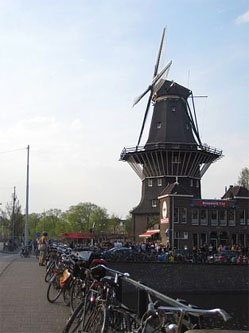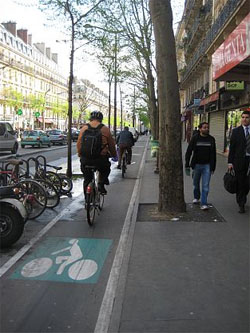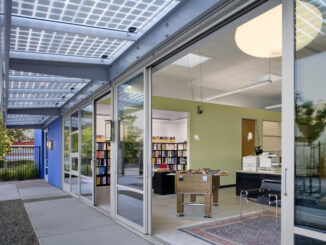
Ah, a windmill and bicycles. Where else could this idyllic scene be other than the Netherlands? This windmill in Amsterdam is indeed a quaint historical relic, but the bikes most assuredly are not. In fact, they are the dominant mode of transportation in the modern-day city by the banks of the Amstel River. What, you may ask, does that have to do with green building? Well, quite a bit, as it turns out.
In the US, for years we have thought of cycling improvements as a nice thing to do. A city decides to spend some a few million dollars on a bike lane here or a pedestrian/cycling path there—isn’t that nice. But take a look at this photo taken in front of Amsterdam’s Central train station.

Yes, folks, that is a multilevel deck with thousands upon thousands of bikes parked on it. That’s what you see in a city where 32% of all trips are taken by bike (versus 6%, if you’re being generous, in oh-so-progressive San Francisco). When bikes aren’t just mixing in traffic but are the biggest component of traffic, that’s truly transformative from an emissions and from an urban livability standpoint. We need to prepare for a greener future of ubiquitous biking when we’re designing our new buildings. Where can you park your fancy bike without worrying about theft? Can you shower? Every single new building should take those sorts of things into account.
Of course, to truly get there, we have to make biking feel completely safe to all kinds of people, not just 20 or 30-something men (still the predominant group of cyclists here in San Francisco). In Amsterdam, riding a bike around town isn’t any more of a statement than driving a Honda would be here: it’s just what you do to get around. Immigrants; unaccompanied kids; even an occasional pregnant woman, all on bikes. The key to getting everyone feeling safe is giving bicycles, wherever possible, complete protection from motorized vehicles. Someone can drive over a painted bike lane, but it would require a lot of determination to drive into a bike lane that’s protected by a curb. Now admittedly, this concerns the public realm rather than buildings themselves, but developers and designers need to become part of the constituency pushing for a public realm that makes biking safer and easier. Yes, it’s greener, but it’s worth something too. Wouldn’t you rather own a building that’s on a great biking street? Here’s an example from Paris, which is determined to follow in the footsteps of Amsterdam, and has been installing bike facilities at a rapid clip in the last few years.

Meanwhile, another step is to do everything possible to flood the streets with bikes. More bikes means that cars expect and respect cyclists more, which means more people feel safe pedaling, and then you end up with a self-reinforcing cycle. (Get it?) One way to do it: Paris, with its Vélib program, has done for bike sharing what City Car Share has done for car sharing in San Francisco. The shared bikes on these racks, available for a fee, are installed in public street areas all over Paris, but maybe in a future program in San Francisco such racks could also be included within new buildings, just like is becoming common with car sharing.

In the Netherlands, cycling isn’t just an urban phenomenon: the whole nation, about twice the size of New Jersey, is blanketed with paved bike routes, reaching from cities to suburbs to rural areas. You can even make a whole vacation out of traveling them, without ever needing to be in a car. Just one word of advice: be sure to be alert when you’re riding in the countryside. If you’re about to ride over something unexpected (like a cattle guard), you may see a sign like this:

So get that Schwinn out of the garage, and start thinking about what we can all do as architects, builders and developers to create new and rehabilitated buildings and an enhanced public realm that gets biking to where it needs to be. Remember, it isn’t just a nice thing to do. The Dutch did it, the Parisians are doing it, so we should be able to do it too. We may even ride over some bumpy terrain on the way, but it’ll be worth it. So keep on rolling, and watch out for those wildroosters.





Be the first to comment